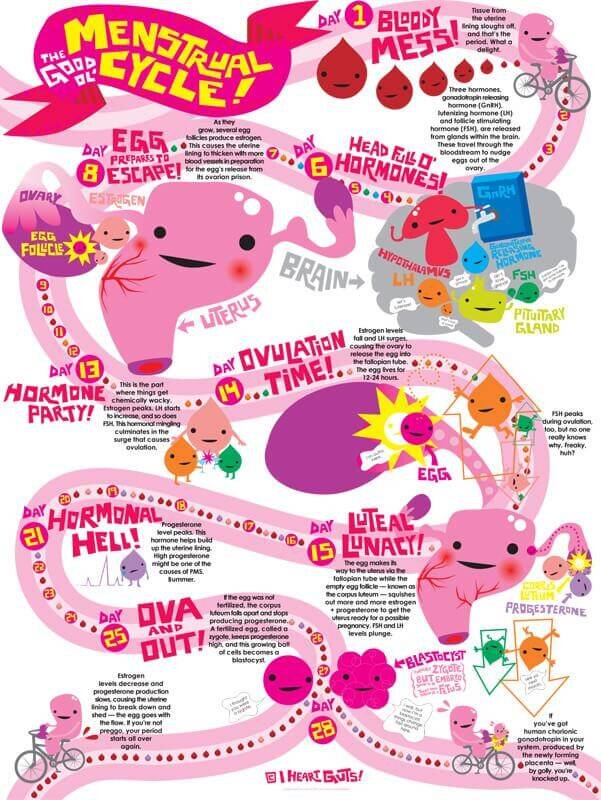
[“The Good Ol’ Menstrual Cycle” poster from “I Heart Guts“]
I’d like to think that I know a lot about my body. The first time I asked, “where do babies come from?” my dad – a doctor – answered my question in full, scientific detail. Since then, I’ve been the girlfriend most likely to answer questions about sex norms and bodily functions, from vaginal discharge (gasp!) to the mechanics of what can and can’t get you pregnant – I’ve never shied away from talking about body stuff and sex ed. At sixteen, I was diagnosed with endometriosis (a painful condition where uterine tissue grows other places in the body), which led me to learn more about my body and how it’s affected by birth control than the average woman. As an adult, I’ve been working with a women’s wellness organization for nearly two years, and I’ve had more doctors examine my lady bits than I’ve had sex partners. Given all these experiences, you’d think I’d know all the important things there are to know about my body and menstrual health. But turns out: I don’t. And if I don’t, you probably don’t either. So, how did this (not) happen, and more importantly: what information are we missing?
During a segment on the sexual education crisis in America, John Oliver reported that “only 22 states mandate sex education, and only 13 require the information to be ‘medically accurate.’” So… using “medically accurate information” in 75% of public schools in the US is… optional?
What about our neighbors to the north with their universal health care…they must have gotten it right, right? Nope: Canadian education and ongoing training of doctors is regularly sponsored by pharmaceutical companies that only spend medical education money on educational programs that can make them money.
What this means: If schools aren’t educating properly and Big Pharma is only in it for the money, then we have to learn about our bodies ourselves.
Let’s start with the basics – if you live in a “cycling body,” you probably know about at least one of these stages. But even if your health education program was stellar, chances are: you probably don’t know the details of all four. While all bodies are different, this biological process is beautiful and complex – but it’s also hormonal and emotional; worry not, I’m here to be your companion through this. Think of me as your cyclical Sherpa for today.
Phase 1: Menstruation (3-7 days)
Progesterone plunges, which triggers the uterine lining to shed. You’ll likely feel tired, and want to withdraw socially. But communication between the left and right hemispheres of the brain is also the most powerful at this time, so it’s a great time to make big decisions. For me, my period is a mostly peaceful, clear-headed time. Also, Thinx (yes, those “period panties”) are the bomb.
Phase 2: Follicular (7-10 days)
Discharge is a bit dry at the start of this phase and the libido is lower. But with a little nudge from your pituitary gland, Follicle Stimulating Hormone (FSH) is released and estrogen and testosterone start to rise, causing your body to build up the uterine lining, prepping for fertilization. Discharge starts feeling sticky, and focus and drive to start new projects can be strong; as you get closer to ovulation, confidence and feelings of sexiness rise. Woo!
Phase 3: Ovulation (2-3 days)
Literally all the hormones in your body join the party: FSH and Luteinizing hormone (LH) spike, as do Estrogen and Testosterone. Discharge is slippery like an egg white. Ovulation triggers changes that make your skin brighter and your face appear more symmetrical. Your body is at its most fertile, and you’ll likely feel sexy, confident, and powerful. Important meetings? Big dates? New headshots? Now is the time!
Phase 4: Luteal (12-16 days)
In the Luteal phase, FSH and LH drop, Progesterone (aka the anti-anxiety hormone) rises and then plummets. Your hormones go from their highest to their lowest in not-that-long of a timespan. Your pain tolerance is noticeably at its lowest during this phase (maybe reschedule that wax), your energy levels may dip, and you might deal with bloating, irritability, headaches, mood swings, and cravings. You may also have a strong urge to nest and end up spending entirely too much money ordering vintage wall hooks on Etsy.
If you learn your cycle, the way you’re feeling in your body will make a whole lot more sense. Find out by tracking your temperature and cervical fluid, and/or with apps like My Flo, and tech like Daysy and Emay (I just started using this one and love it!). This knowledge has helped me to feel a LOT more in control and at peace.
What were your experiences learning about your body? Who was the most helpful resource? What surprises did you encounter that you wish that someone had told you in advance?
Want more information? Comment below, find me on Twitter or Instagram @SarahKleg, and here is some suggested reading and resources:
- Wrestling With Menstruation: https://www.atthewellproject.com/shop/buy-wrestling-with-menstruation
- Cycles + Sex: https://www.cyclesandsex.com/
- Prenatal, Birth and Attachment: https://www.prenatalbirthandattachmentclinic.com/workshops/training
- Research on the Nuva Ring
- Study by Hum Brain Mapp published by the US National Library of Medicine about how hormonal birth control pills affect the brain.
- Abby Epstein and Ricki Lake talk hormonal birth control
- Plan C emergency at-home birth control
- Planned Parenthood health center

Sarah Klegman is a creative writer and storyteller, host of the podcast “What’s Wrong With You?” on the Awkward Human Network, and co-founder of the carb-loving community: Challah Hub. Her work has been featured in a handful of publications including The Huffington Post, The LA Times, The Dodo, and XO Jane. She’s made enthusiastic appearances of arguable significance on Comedy Central, The Great British Baking Show on PBS, and KTLA. Find her speaking at events and festivals around the world, or performing regularly on storytelling shows in Los Angeles.


Grok Nation Comment Policy
We welcome thoughtful, grokky comments—keep your negativity and spam to yourself. Please read our Comment Policy before commenting.